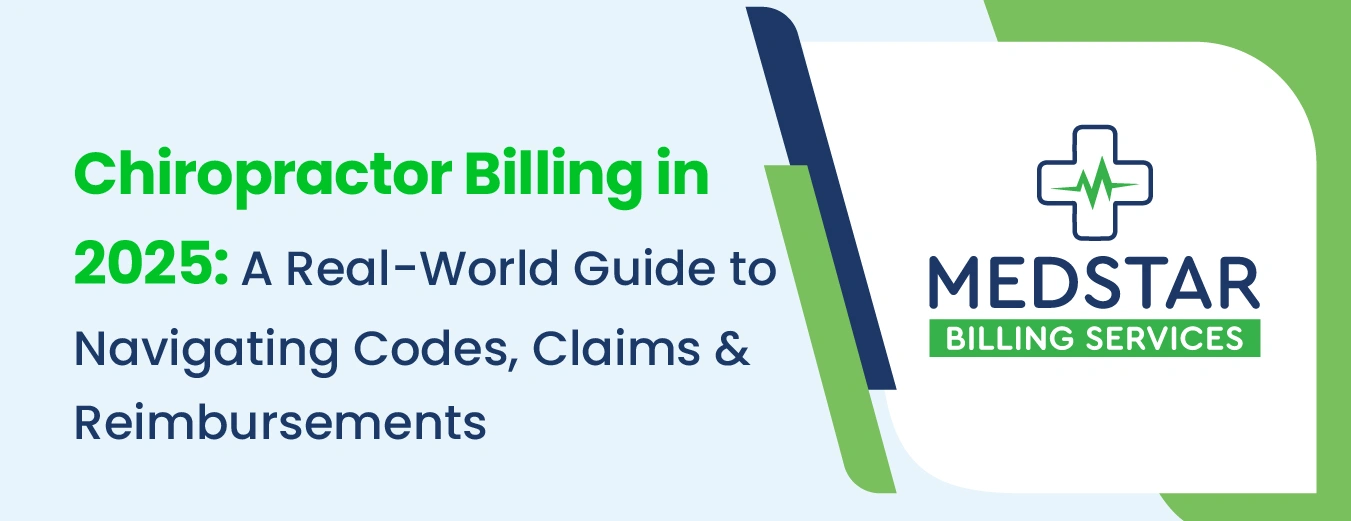The Not-So-Adjustable Truth Behind Chiropractic Billing
When people think of chiropractors, they often imagine a few spine pops and neck cracks and assume the billing process is just as straightforward. But ask anyone in the billing department of a chiropractic practice, and they’ll tell you—it’s a minefield of CPT codes, ICD-10 diagnoses, payer rules, medical necessity documentation, and ever-changing reimbursement rates.
In 2025, billing for chiropractic services is more precise and regulated than ever before. The rise in claims scrutiny, paired with CMS reimbursement tweaks, means providers have to stay sharp, both in alignment and in administrative accuracy. Let’s peel back the layers and walk through the current billing and coding landscape for chiropractors.
Understanding the Foundation of Chiropractic Billing
Chiropractic billing begins with correct CPT (Current Procedural Terminology) codes for the services provided and ICD-10-CM codes for the diagnoses. But here’s the catch: chiropractic billing is not like billing for general medicine. Payers, particularly Medicare, have strict limits on what’s covered and what’s considered “medically necessary.”
Here’s a quick glance at the main CPT codes used in chiropractic billing:
| CPT Code | Description |
| 98940 | Chiropractic manipulation (1–2 spinal regions) |
| 98941 | Chiropractic manipulation (3–4 spinal regions) |
| 98942 | Chiropractic manipulation (5 spinal regions) |
| 98943 | Extraspinal manipulation (e.g., extremities like the shoulder, knee, etc.) |
Most chiropractic practices are supported by these codes but the amount of regions treated needs to translate into the documentation and have to correlate towards active symptoms that are documented by the ICD-10 codes.
Common ICD-10 Codes in Chiropractic Billing
ICD-10 codes should always justify medical necessity. Here are some of the most commonly used diagnoses:
| ICD-10 Code | Description |
| M54.5 | Low back pain |
| M54.2 | Cervicalgia (neck pain) |
| M99.01 – M99.05 | Segmental and somatic dysfunction (used to identify spinal regions needing adjustment) |
| M25.511 | Pain in the right shoulder |
| M79.1 | Myalgia (muscle pain) |
Pro Tip: Never use generic codes like “M54.9 – Back pain, unspecified” unless absolutely necessary. Payers hate vague diagnoses.
Reimbursement Landscape in 2025
Representatively, the reimbursement value (of chiropractic) has been rather modest, albeit CMS and other private payers have slightly changed the fee schedules in 2025 towards those providers that display clear documentation and compliance.
This is a new forecast in 2025 of national average reimbursement rates as shown below:
| CPT Code | 2025 Avg. Medicare Rate |
| 98940 | $27.60 |
| 98941 | $39.80 |
| 98942 | $50.90 |
| 98943 | $25.00 |
Note: These numbers are based on Medicare. Commercial insurance rates can be 10–25% higher, depending on the payer and contract terms.
Big Change in 2025: Documentation Enforcement
One of the biggest shakeups in 2025 is Medicare’s “Documentation Compliance Audit Initiative” for chiropractors. Random post-payment reviews are more common, and CMS has narrowed the definition of “maintenance therapy,” which is not reimbursable.
To secure payment, chiropractors must now clearly show:
- Initial treatment plan with short-term goals.
- Re-evaluate the schedule every 30 days or sooner.
- Subjective & objective findings, not just patient complaints.
- Use of outcome assessments (like Oswestry or NDI).
Common Billing Pitfalls in 2025 (and How to Dodge Them)
- Upcoding Spinal Regions: Billing 98942 (5 regions) when only 2 were treated = audit magnet.
- Missing Diagnosis Linkage: Using a diagnosis code unrelated to the adjusted spinal region.
- Overusing M54.5: It’s popular, but overuse raises red flags.
- No AT Modifier for Medicare: If you forgot it, your claim’s heading to the reject pile.
Pro Tip: Always double-check that each CPT code has an ICD-10 that supports it, and that your documentation can back it up.
Mastering Modifiers, Audits & Payer-Specific Rules Like a Pro
So, we’ve tackled the basics — CPTs, ICDs, and reimbursement rates. But any seasoned chiropractic biller will tell you: it’s the modifiers and payer nuances that make or break clean claim submission. One misstep, and you’re dealing with rejections, denials, or worse — pre-payment audits.
Let’s cut through the chaos and look at how to code smart in 2025, while staying ahead of audit flags.
Decoding the Most Crucial Modifiers in Chiropractic Billing
Modifiers clarify the “how” and “why” behind a procedure. For chiropractors, one in particular is your best friend — or worst enemy if forgotten.
- Modifier AT – “Active Treatment”
- Required on all Medicare claims for spinal manipulation (98940–98942).
- Indicates the treatment is medically necessary and not maintenance.
- Without it, Medicare will deny your claim as “maintenance therapy.”
Tip: You must have a valid treatment plan and measurable goals to justify this modifier. If there’s no improvement in the patient’s condition, it could be flagged, even if the AT modifier is used.
- Modifier GA – Waiver of Liability
- Used when you suspect Medicare won’t pay, and the patient has signed an ABN (Advance Beneficiary Notice).
- Shows that the patient understands and agrees to pay if the claim is denied.
- Modifier GY – Non-Covered Services
- Used when billing services that are never covered by Medicare, like maintenance care or non-spinal adjustments (e.g., 98943).
- Modifier 25 – Significant, Separately Identifiable E/M
- If a patient receives an exam and an adjustment on the same day, use this with an E/M code (99202–99215).
- Must have separate documentation for the evaluation and the manipulation.
Surviving the 2025 Audit Wave
The Office of Inspector General (OIG) and CMS are turning more attention to chiropractors in 2025. Why? Because audits in 2023–24 revealed high error rates in chiropractic claims, especially with improper use of AT modifiers, lack of documentation, and billing maintenance therapy as active care.
Here’s what payers are flagging in 2025:
- Repeated use of the same diagnosis codes for months.
- No improvement documented in SOAP notes.
- Prolonged care with no re-exam or discharge plan.
- Spinal manipulation billed for every visit, without clinical justification.
Protect yourself: Perform routine internal audits every quarter. Use audit tools or hire external coders for random chart reviews. It’s a small investment that saves big on recoupments.
Chiropractic Billing Payer-Specific Guidelines 2025
Unlike Medicare, which is the most difficult in relation to chiropractic, the private payers are not a piece of cake either. All of them have their peculiarities:
| Payer | Notable Billing Rule (2025) |
| Medicare | Only spinal CMT is covered. Must use AT modifier. No extraspinal (98943) covered. |
| Blue Cross Blue Shield | Some states allow CMT + E/M codes together with modifier 25, but others don’t. |
| UnitedHealthcare | Requires authorization after initial visits for more than 12 sessions per year. |
| Cigna | Now requiring outcome-based tools like VAS, Oswestry, or NDI every 30 days. |
| Aetna | Increasing use of AI-driven claim reviews. Consistency in documentation is key. |
How About Extraspinal Adjustments?
Here’s a big source of confusion: CPT 98943 (extraspinal manipulation) is not covered by Medicare, and many payers limit its use or require clear justification. Think knee, shoulder, elbow, TMJ — that’s all extraspinal.
Tip: When billing 98943, pair it with a specific diagnosis code for that region, like:
- M25.511 – Pain in right shoulder
- M25.571 – Pain in right ankle
- M79.604 – Pain in right leg
Use modifier 59 if billed on the same day as a spinal CMT to show it’s a distinct procedure.
Real-World Tip: Keep a Billing “Cheat Sheet”
Keep a physical or digital quick-reference guide at your billing station with:
- Common CPTs and ICDs used
- Which modifiers go with which codes
- Payer-specific quirks (especially for BCBS, UHC, and Medicare)
- Maximum allowed visits per plan
Remember: Most denials don’t come from doing the procedure wrong — they come from documenting or coding it wrong.
Coding Scenarios, Denial Management & Reimbursement Realities
Billing in a chiropractic clinic is like solving a new puzzle every day — no two claims are quite the same, and the stakes are higher than ever in 2025. From selecting the correct evaluation code to dealing with denials and appeals, chiropractors need a system that’s not just efficient — it has to be smart and audit-proof.
Let’s get hands-on and walk through practical coding scenarios, what to do when things go wrong, and what the new reimbursement adjustments mean for your bottom line this year.
Chiropractic Evaluation & Management (E/M) Codes
Though spinal adjustments are the core of chiropractic procedures, most of chiropractors also cover preliminary examination and re-examination, either on new patients or ones that are evolving. E/M codes come in there.
The following are the most usual codes:
| CPT Code | Description | 2025 Avg. Rate |
| 99202 | New patient, straightforward (15–29 mins) | $85.40 |
| 99203 | New patient, low complexity (30–44 mins) | $123.15 |
| 99211 | Established patient, minimal visit | $25.10 |
| 99212 | Established patient, low complexity (10–19 mins) | $58.30 |
Tip: Use modifier 25 when billing an E/M visit on the same day as a chiropractic adjustment — and be sure the evaluation was truly separately identifiable (e.g., a new condition or new injury area).
Real-World Coding Examples
Scenario 1:
- Patient Complaint: Mid and lower back pain
- Exam Findings: T7–T9 and L4–L5 dysfunction
- Service Rendered: Chiropractic manipulation to thoracic and lumbar regions
Claim:
- CPT: 98941 (3–4 spinal regions)
- ICD-10: M99.03, M99.05, M54.5
- Modifier: AT (if Medicare)
Scenario 2:
- Patient Complaint: Neck pain and left shoulder stiffness
- Service Rendered: Cervical adjustment and extraspinal manipulation of left shoulder
Claim:
- CPT: 98940 + 98943
- ICD-10: M54.2, M25.512
- Modifiers: 59 (on 98943), AT (if Medicare — but remember, 98943 is non-covered)
When Claims Are Denied: What Now?
Even when you do everything right, denials can happen, especially with today’s automated claim review systems. Here’s a workflow to keep in place in 2025:
List of Checks to Chiropractic Denial:
- Do not be hasty in reading the EOB: Is it a coverage denial or coding error?
- Do a Common Error Check:
- Lack of modifier (AT or 25 usually)
- Unreliable ICD connection
- Bad diagnosis (e.g., unspecified or chronic code that lacks acute flare-up)
- Look up through Documentation: Was the SOAP note neat and extensive?
- Appeal Letter Time: Submit within 30–45 days with:
- Proper documentation
- Clarification of medical necessity
- Highlight of guidelines if payer misinterpreted the coding
Pro Tip: Keep templates ready for appeal letters. It saves time and increases your chance of overturning denials quickly.
Reimbursement Shifts in 2025 — What’s the Bottom Line?
In 2025, chiropractors are seeing a slight uptick in Medicare rates, particularly for 98941 and 98942. However, that bump comes with strings attached: more compliance rules, outcome tracking, and prior authorization policies.
Here’s how things have shifted:
| Code | 2024 Avg. Medicare Rate | 2025 Rate | Change |
| 98940 | $26.10 | $27.60 | +$1.50 |
| 98941 | $37.40 | $39.80 | +$2.40 |
| 98942 | $48.80 | $50.90 | +$2.10 |
But it’s not just about rates — payers are expecting more proof of effectiveness.
Some changes taking effect in 2025:
- UnitedHealthcare and Cigna now require a minimum of 2 outcome assessment scores every 30 days.
- Some BCBS plans are trialing pre-payment reviews for high-volume providers.
- CMS is hinting at a future MIPS-like program for chiropractors, which could tie future reimbursement to clinical outcomes and cost-efficiency.
Quick Tips to Stay Profitable in 2025
- Use treatment plans that specify region, frequency, and goals. Update regularly.
- Don’t rely on “just adjustments” — E/M codes can boost revenue if used compliantly.
- Train your front desk and billing staff on basic coding. One wrong entry = lost income.
- Invest in billing software with chiropractic templates, audit tracking, and modifier alerts.
Remember: 80% of chiropractic audits in 2024 resulted in claim recoupments. In 2025, it’s not about more patients — it’s about better coding and cleaner claims.
FAQs, Billing Cheat Sheets & Staying Ahead of the Curve
As we round off this deep dive into chiropractic billing, one thing’s clear: 2025 is all about precision, proof, and preparedness. Chiropractors who take the time to code properly, document thoroughly, and understand the rules of the game won’t just get paid faster — they’ll also avoid the traps that lead to audits and revenue loss.
To make your day-to-day easier, let’s go through a practical cheat sheet, clear up frequently asked questions, and end with a billing-ready mindset for the rest of the year.
Your 2025 Chiropractic Billing Cheat Sheet
| Billing Element | Details |
| Spinal CPT Codes | 98940 (1–2), 98941 (3–4), 98942 (5 regions) |
| Extraspinal Code | 98943 (shoulders, elbows, knees, etc.) – Medicare does not cover this |
| E/M Codes | 99202–99203 (new patients), 99212 (established) – use with modifier 25 |
| Key Modifiers | AT (Medicare active care), 25 (E/M same day), 59 (distinct procedure), GA/GY (Medicare non-covered care) |
| Common ICD-10s | M54.5 (low back pain), M54.2 (neck pain), M99.01–M99.05 (subluxation by spinal region) |
| Medicare Alert | Only spinal manipulation is covered, and only with AT modifier + proper documentation |
Frequently Asked Questions (FAQs)
Can chiropractors bill for therapeutic modalities (e.g., ultrasound, manual therapy)?
Yes — services like 97140 (manual therapy) or 97012 (mechanical traction) are billable when clinically justified. However, many payers require clear separation from manipulation and diagnosis linkage. Use modifier 59 if needed.
Is there a cap on the number of chiropractic visits per year?
Medicare doesn’t specify a hard cap, but continued visits must show improvement. Most private insurers cap visits at 10–20 per year, unless there’s preauthorization or an updated treatment plan.
What’s the best way to prove “medical necessity”?
- Use region-specific ICD-10 codes
- Document objective findings (e.g., palpation, range of motion, orthopedic testing)
- Include treatment goals and update them regularly
- Conduct periodic re-evaluations
What happens if I forget to add the AT modifier on a Medicare claim?
The claim will likely be denied as maintenance care. You can correct and resubmit, but frequent omissions may trigger pre-payment audits or loss of privileges with CMS.
Real Talk: Staying Profitable in 2025 Without Getting Burned
Chiropractors often work hard for relatively modest reimbursement rates. That means every under-coded visit or missed modifier directly hurts your revenue.
Here’s what top-performing clinics are doing this year:
- Audit internally every 30–60 days
- Bundle services smartly — use CMT + E/M visits when appropriate
- Train your front desk on coverage policies, ABN usage, and modifier requirements
- Use billing software with built-in alerts for missing documentation or modifier errors
- Track payer behavior — if UnitedHealthcare starts denying your 98941s, investigate fast
Tip from a billing coach: “Don’t just learn codes. Learn patterns. Know what payers like and what makes them squint. That’s where the real money is.”
Tools You Should Be Using in 2025
- Outcome Measure Templates: Oswestry, Neck Disability Index (NDI), Visual Analog Scale (VAS)
- Cheat Sheets for CPT/ICD codes, modifiers, and common visit combos
- Custom SOAP note macros: Include clinical rationale, region treated, and goals
- Audit Logs: Record when and how treatment plans were updated
- Billing Dashboards: Visualize which claims are stuck, denied, or about to hit appeal deadlines
Final Thoughts: Aligning Billing with Better Outcomes
Billing may not be as glamorous as the adjustment table, but in 2025, it’s just as important. Your care can only make a difference if it’s paid for properly, and staying on top of documentation, coding changes, and payer trends is how you protect your practice, your license, and your patients’ continuity of care.
So, consider this your billing adjustment: small tweaks today lead to long-term alignment in your revenue cycle. In order to get detailed and updated information about medical coding and billing, go through other articles on the website, and don’t forget to ring “Medstar Billing Services“ to get a hundred percent accurate reimbursement for your services.
Wrap-Up Summary Table
| What You Learned | Key Takeaway |
| Coding Basics | 98940–98943 are essential codes; use ICDs that justify each adjustment |
| Modifiers | AT, 25, 59 are your best allies — don’t skip them |
| Reimbursement 2025 | Slight rate increases, but tougher documentation rules |
| Audit Protection | Strong SOAP notes + updated treatment plans = survival |
| Denial Management | Track, appeal, adjust — don’t ignore those EOBs |
| Real Tools | Cheat sheets, software, and training go a long way |





